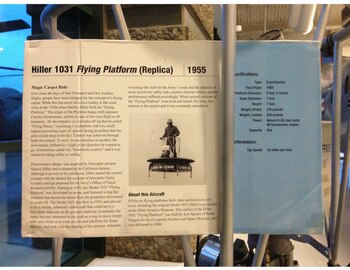avia.wikisort.org - Helicopter
The Hiller VZ-1 Pawnee (U.S. Army designation; earlier Army designation: HO-1) was a unique direct-lift rotor aircraft, using contra-rotating ducted fans for lift inside a platform upon which the single pilot shifted body weight for directional control. The platform was developed starting in 1953 under an Office of Naval Research (ONR) contract to Hiller Aircraft, and flew successfully beginning in 1955.[1]
| VZ-1 Pawnee | |
|---|---|
 | |
| Role | Direct-lift rotor aircraft |
| Manufacturer | Hiller Aircraft |
| First flight | 1955 |
| Status | Experimental |
| Primary user | United States Army |
| Number built | 6 |
Design and development
The original concept had been developed by Charles H. Zimmerman in the late 1940s.[2] Further development followed, both by Hiller Aircraft and the De Lackner Company. There were two main models, the ONR model 1031-A-1, and the somewhat larger VZ-1 Pawnee model produced in 1956 for the U.S. Army. Three of each model were built as prototypes. Neither of the variants was put into production.[3]
The smaller ONR model used two 44 horsepower (33 kW) Nelson H-59 piston engines, coupled to the propellers by a modified helicopter transmission built by the Industrial Power Division of Hall-Scott. The larger Pawnee model used three of those engines and had an extended duct area. The Pawnee had ineffective "kinesthetic control" and instead had the operator seated on a platform controlling the flight with conventional helicopter controls.[4]
Testing and evaluation
Due to aerodynamic effects in the duct within which the propellers rotated, the platform was dynamically stable, even though the pilot and center of gravity of the platform were fairly high up. In testing, the prototypes flew well, but the U.S. Army judged them to be impractical as combat vehicles as they were small, limited in speed and only barely flew out of the ground cushion effect.[5]
Two of the six prototypes are known to survive; both are ONR 1031-A-1 models. One is located at the Hiller Aviation Museum in San Carlos, California, the other is at the National Air and Space Museum's Udvar-Hazy Center in Chantilly, Virginia.[6] The latter platform was formerly on loan to the Pima Air & Space Museum. A replica of the 1031 platform is on display at the Evergreen Aviation & Space Museum.
Gallery
- Hiller 1031-A-1 at Udvar-Hazy Center
- Reproduction of the Hiller 1031 Flying Platform, built by Ken Spence of Bend, Oregon in 2006.
 Placard describing the reproduction of the Hiller 1031 on display at the Evergreen Aircraft Museum.
Placard describing the reproduction of the Hiller 1031 on display at the Evergreen Aircraft Museum.
Specifications (Model 1031-A-1)
Data from National Air and Space Museum[6] and Hall-Scott Motor Company[7]
General characteristics
- Crew: 1
- Capacity: 185 lb (84 kg) payload
- Diameter: 8 ft 4 in (2.54 m)
- Height: 7 ft (2.1 m)
- Empty weight: 370 lb (168 kg)
- Max takeoff weight: 555 lb (252 kg)
- Powerplant: 3 × Nelson H-59 4-cylinder air-cooled horizontally-opposed piston engines, 40 hp (30 kW) each at 4,000 rpm
- Transmission: Hall-Scott helicopter variant
- Main rotor diameter: 2 × 7 ft (2.1 m)
- Main rotor area: 76.98 sq ft (7.152 m2) 2 × contra-rotating two-bladed aluminum
Performance
- Maximum speed: 16 mph (26 km/h, 14 kn)
- Service ceiling: 32.8 ft (10.0 m)
See also
- Williams X-Jet
Aircraft of comparable role, configuration, and era
- Bensen B-10
- De Lackner HZ-1 Aerocycle
Related lists
- List of military aircraft of the United States
References
- Notes
- Rogers 1989, pp. 74–78.
- Taylor 1999, p. 104.
- Rogers 1989, p. 78.
- Winchester 2005, pp. 130–131.
- Winchester 2005, p. 130.
- "Hiller Model 1031-A-1 Flying Platform." Smithsonian National Air and Space Museum. Retrieved: 2 November 2011.
- 1955 Hall-Scott Industrial Power Division Annual Report
- Bibliography
- Rogers, Mike (1989). VTOL: Military Research Aircraft. New York: Orion. ISBN 978-0-517-57684-7.
- Taylor, Michael John Haddrick (1999). The World's Strangest Aircraft. London: Grange. ISBN 978-0-7607-2102-5.
- Winchester, Jim (2005). The World's Worst Aircraft: From Pioneering Failures to Multimillion Dollar Disasters. London: Amber. ISBN 978-1-904687-34-4.
- Bradford, Francis H.; Dias, Ric A. (2007). Hall-Scott: The Untold Story of a Great American Engine Maker. Warrendale, PA: SAE International. ISBN 978-0-7680-1660-4.
External links
На других языках
[de] Hiller VZ-1
Die Hiller VZ-1 Pawnee (Werksbezeichnung Model 1031) war ein senkrecht start- und landefähiges Luftfahrzeug des US-amerikanischen Herstellers Hiller Helicopters Company, das von der konstruktiven Auslegung her, als Kleinsthubschrauber angesehen werden kann. Es wurden mindestens drei Prototypen gebaut. Eine ähnliche Entwicklung stellt das in jüngster Zeit (2019) bekannt gewordene Flyboard Air von Franky Zapata dar. Hier werden jedoch statt der durch Kolbenmotoren angetriebenen Rotoren, Strahltriebwerke verwendet.- [en] Hiller VZ-1 Pawnee
[fr] Hiller VZ-1 Pawnee
Le Hiller VZ-1 Pawnee (désignation précédente de l'US Army : HO-1) était un concept de plateforme ADAV à aile annulaire de type « coléoptère », conçu aux États-Unis au début des années 1950. L'appareil faisait appel à deux soufflantes carénées contrarotatives pour produire une portance verticale soulevant une plateforme sur laquelle était installé un soldat, qui contrôlait les mouvements de l'appareil en faisant bouger son centre de gravité (on parle parfois de plateforme « kinesthésiquement pilotée »).[ru] Hiller VZ-1 Pawnee
Hiller VZ-1 Pawnee — летательный аппарат («летающая платформа») фирмы Hiller Aircraft c двумя соосными винтами, заключенными в дюралюминиевое кольцо-кожух, которые приводились во вращение двумя двигателями Nelson H-56 воздушного охлаждения. В центре платформы находилась площадка для пилота, пульт управления и несколько приборов.[1]. Скорость и направление движения аппарата пилот мог изменять, смещая положение своего тела. Всего было построено 6 аппаратов трех типов, отличающихся силовыми установками и размерами кольцевого кожуха. Первый полет состоялся 9 февраля 1955 года. Программа была закрыта в 1963 году.Другой контент может иметь иную лицензию. Перед использованием материалов сайта WikiSort.org внимательно изучите правила лицензирования конкретных элементов наполнения сайта.
WikiSort.org - проект по пересортировке и дополнению контента Википедии


